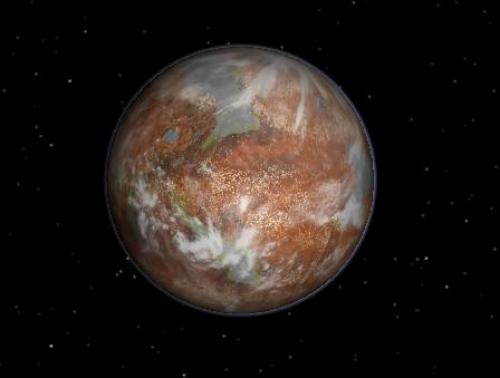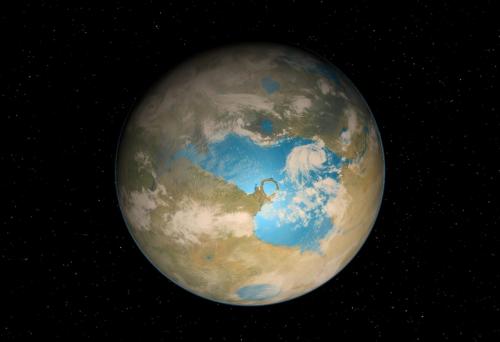BY LETTER
Deucalion
Galactography > Regions of Space > Inner Sphere
Galactography > Systems and Worlds > Systems & Worlds C - D
Galactography > Systems and Worlds > Systems & Worlds C - D
Mars-like world which developed a rich artistic culture | |
 Image from Steve Bowers | |
| Deucalion's cratered surface is easily recognisable from orbit | |
Deucalion - Data Panel | |
| Star | HD 2071 |
|---|---|
| Class: | G8/G5 |
| Luminosity: | 0.8 Sol |
| Colonised | 2603AT |
| Region: | Inner Sphere, Constellation Phoenix; Distance from Sol 90 ly |
| Planets: | a Struwwelpeter, diameter 4210 km, Ferrinian type Orbit 0.4 AU b Deucalion, diameter 6082 km, AreanLacustric type world, Orbit 1.032 AU; Orbital Period 1.08 standard years c Belenus Diameter 150,000km Jovian type (3x Jupiter masses) Orbit 5.9 AU |
| Wormhole | Noah's Arc to Frog's Head |
 Image from Steve Bowers | |
| Deucalion before terraforming | |
This young Mars-like planet has a thick atmosphere of CO2, N2 and a surprisingly high hydrogen content; as the hydrogen boils off it drags the rest of the atmosphere with it.
Frequent impacts also eject a high proportion of the volatiles, never to return.
The seas are bitterly cold, and have a high sulphuric acid content; in less than a billion years this world would be dry and salty on the surface; however, if all goes as expected, the efforts of the Phoenix Sector
Terraformation Corporation will divert the environment of this inhospitable world towards an Earth-like future.
(end report)
Terraformation
HD 2071 was first explored in 2603 a.t. by an automated probe belonging to the Phoenix Sector Terraformation Corporation; these probes were sent out from Audobon system in Grus as part of the Linnent Empire. The second planet, named Deucalion, displayed characteristics similar to the earliest stage of geological history on the planet Mars in the Old Solar system. With a thick atmosphere and plenty of water the terraforming process was expected to be fairly straightforward, although the sulphuric acid seas would present an interesting problem.Contact was maintained within the Linnent empire by use of the Engenerator copying system; by 2603 the Wormhole Nexus had already reached the nearby world of Trees at HD 3823, but no wormhole connection was made from Trees to Deucalion for another six hundred years. By this time several million colonists had been copied to the HD 2071 system from Audobon and elsewhere, and the terraforming of this bitter planet was well under way.
The large asteroid belt between Deucalion and Belenus was the location of many minor objects in this relatively young system; the Belenus Belters soon became successful and wealthy, while marshalling the many rocks in the system away from inhabited areas became an important task. The PSTC hyperturing in charge of development of this complex system, Ask Bryan, who in fact had once been a human inhabitant of Terranova a thousand years before, was kept busy by this constant vigil, and by the enormous task of terraforming Deucalion itself. By 3415 a.t. the carbon dioxide in the atmosphere had been half replaced by oxygen but the seas were slow to lose their sulphurous burden, so Ask Bryan began to prepare a sulphur tolerant tweak genome for the new citizens of Deucalion. This modification would allow them to commence colonisation perhaps a thousand years before the planet became fully Earth-like. Soon a number of open air-cities were growing in the rapidly changing landscape of Green Deucalion, a forbidding environment to the non-adapted baseline humans from the Belt and the few relativistic spacecraft that arrived from the worlds of Frog's Head and elsewhere.
 Image from Steve Bowers | |
| Even after terraformation the planet shows many signs of ancient meteor impacts | |
With help from the su-cyborg Conver Ambi, the various control functions were linked to a clade of enhanced humans called the Steersmen. Most of the terraforming and asteroid-monitoring equipment functioned automatically, so the Steersmen found themselves in the decision making role often filled by transapient AI entities. As the Deucalion experiment continued, it became a fine example of a solar system operating without hyperintelligent AI; many other systems have adopted this strategy, but Deucalion was for thousands of years one of the most successful.
The Essentialist and Immaterialist movements
When the Conver Ambi empire collapsed, Deucalion became allied to the Negentropy Alliance; a strong contingent of enhanced human warriors were sent into battle during the Version War, but they saw little actual fighting (few humans did); instead they found themselves employed as occupation forces on several conquered NoCoZo and independent worlds.Although the Deucalion Corps carried out this duty with efficiency and compassion, the moral ambiguity involved with depriving the native population on several worlds of real freedom weighed heavily upon many veterans.
After the War the world of Deucalion turned in upon itself; with no guiding AI to set their moral compass, the people of this advanced human civilisation developed a cloistered, aesthetic zeitgeist, and developed a culture largely based around artistic achievements of various kinds. After less than a thousand years, the artists of Deucalion tended to align themselves with one of two movements or artistic religions, each very different.
The Essentialist movement were influenced by the materialist philosophy of the Mutual Progress Alliance, and believed that the concrete existence of things, of objects in themselves, should be celebrated; they proceeded to do that by realistic, even hyperrealistic, representations of actual objects and scenes in a variety of media. They claimed to be able to capture the essential reality of material things, albeit translated into various different substances. Still-lifes, portraits, narrative painting in 2D; sculpture and tableaux, made from a variety of temporary and durable media were popular; wood carving in particular was a local speciality, as many of the arboreal organisms native to Trees had been imported into the local ecosphere, somewhat adapted to the low chlorine, high sulphate soil. This figurative work was realistic, but often portrayed real subjects at an unexpected scale; giant human figures were shown in the act of fighting, speechmaking, socialising, lovemaking; while small or tiny human figures, animals, spacecraft, buildings, trees, cities, worlds were created, often in unpainted wood, depicting the beauty in large scale patterns of nature and human constructs.
On the other hand the Immaterialists disdained figurative work or realistic depictions of objects; they attempted to directly display emotions and mental states in painting, sculpture, and also artworks made from light, flowing water or other moving media, light and sound; they found inspiration in a thousand artistic traditions across the Orion's Arm civilisation, and particularly, after 8750 a.t., in the demonic paintings of the alien race the Limners. This race of intelligent crustacean-like creatures has a strong tradition of memetically powerful art, which is capable of instilling the equivalent of terror or other strong emotions in that race; the Immaterialists, and especially the Demonist movement, attempted to recreate this powerful effect in artwork tailored for the human psyche. Works such as Angst (9109) and Futile Hope (9121) demonstrated that a combination of skill and deep emotional investment on the part of the artist could produce terrifying results.
Between the Version War and the current era, these artistic differences developed into several fierce conflicts, some purely ideological, some fought with actual weapons; the war in 7998 saw the destruction of the entire artistic colony on the major moon Jason by kinetic weaponry.
By the last half of the tenth millennium a.t. the achievements of the artistic communities had reached a peak, and disillusion set in; many of the population started to follow a widespread religious/transcendence movement called the Exponents of Joy, who promised a quick and dirty transition into transapience, using Keterist or TRHN techniques. The Exponents had been active in a small way since the early history of this world, and represented a moderating force on the artistic religions; now the obsessive Essentialists and the other-worldly Immaterialists lost their popularity among the people of Deucalion, and humanity transcended in vast numbers.
Decline and renaissance
For the most part those who ascended during this period left the Deucalion system to dwell in the greater Noosphere of the Nexus databanks. A few of the ascended remained behind to observe the largely empty world as it fell into decline due to depopulation.For a couple of centuries a few diehard artistic souls haunted the decaying wooden towns and cities as they rotted, crumbled and spontaneously combusted. Deucalion was left largely vacant for three hundred years, its cities the haunt of feral pets and wild animals.
It has taken a new wave of entirely different immigrants, (Genen families from Iota Horologi and Parthenes from Aung San Suu Kyi) to breathe new life into this old world once more. So far these two quite different cultures co-exist in relative harmony, but some commentators suggest that there may be problems in the centuries to come.
Related Articles
Appears in Topics
Development Notes
Text by Steve Bowers
Initially published on 27 March 2004.
Initially published on 27 March 2004.






